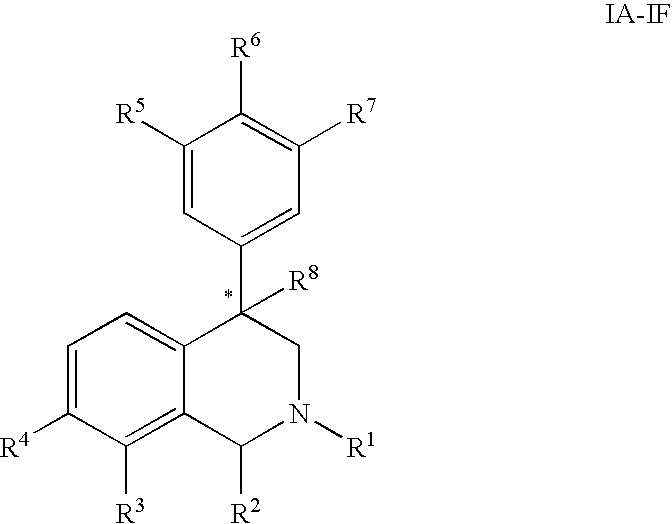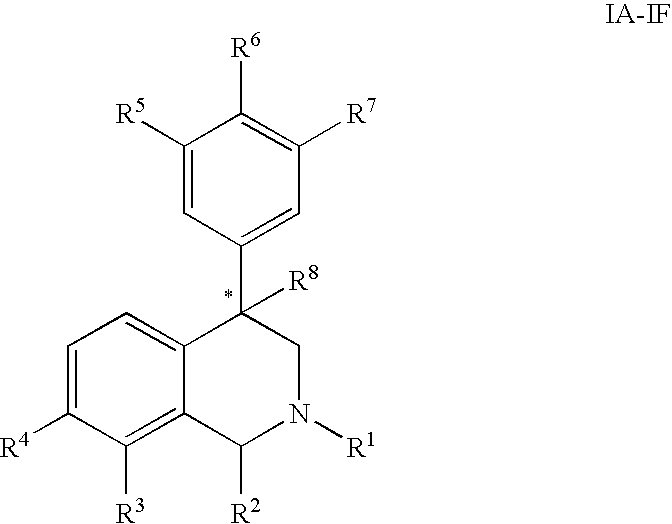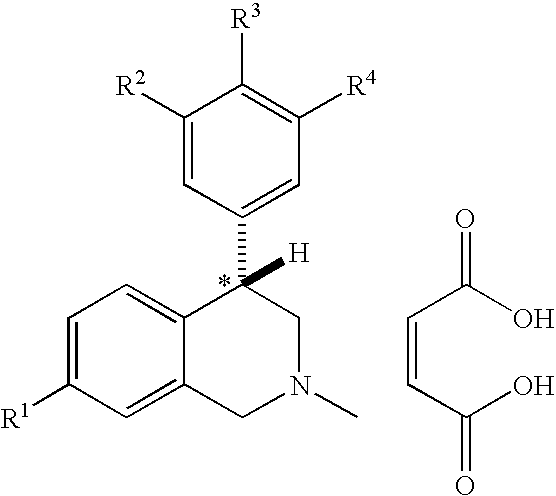4-phenyl substituted tetrahydroisoquinolines and use thereof
a technology of tetrahydroisoquinoline and phenyl, which is applied in the direction of heterocyclic compound active ingredients, biocide, drug compositions, etc., can solve the problems of increased blood pressure and heart rate, insomnia and jittery feelings, insomnia,
- Summary
- Abstract
- Description
- Claims
- Application Information
AI Technical Summary
Problems solved by technology
Method used
Image
Examples
example 1
Preparation of 2,7-dimethyl-4-phenyl-1,2,3,4-tetrahydroisoquinoline
[0308]Step A: A solution of m tolualdehyde (500 mg; 4.16-mmol), □-(methylaminomethyl)benzyl alcohol (630 mg, 4.16 mmol) and acetic acid (0.5 ml) was stirred in methanol (16 ml) at 0° C. under nitrogen as sodium cyanoborohydride (784 mg, 12.5 mmol) was added in small portions. The reaction mixture was stirred for 5 minutes at 0° C. and two days at ambient temperature. The reaction mixture was brought to pH 12 with 2N sodium hydroxide, diluted with water, and extracted with diethyl ether (3×). The combined organic extracts were washed with brine, dried over anhydrous magnesium sulfate, and the solvent removed in vacuo to provide the desired intermediate (1.24 g): 1H NMR (300 MHz, CDCl3) δ 7.08–7.35 (m, 9H), 4.73–4.77 (m, 1H), 3.71 (d, J=13.0 Hz, 1H), 3.50 (d, J=13.0 Hz, 1H), 2.46–2.67 (m, 2H), 2.36 (s, 3H), 2.32 (s, 3H); CI MS m / z=256 [C17H21NO+H]+.
[0309]Step B: The product from Step A (1.24 g, 4.90 mmol) was stirred i...
example 4
Preparation of 2,7-dimethyl-4-(3-fluorophenyl)-1,2,3,4-tetrahydroisoquinoline
[0311]Step A: m-Tolualdehyde (1.66 g, 14.0 mmol) was treated with methyl amine (40% aqueous, 1.39 ml, 18.0 mmol) in methanol (20 ml) at room temperature. The reaction was stirred 20 minutes and treated with sodium borohydride (0.26 g, 7.0 mmol) portionwise. The reaction was stirred 1 hour and treated with 3′-fluoro-2-bromoacetophenone (3.0 g, 14.0 mmol) followed by stirring for 45 minutes at room temperature. The reaction was finally treated with sodium borohydride (0.52 g, 14.0 mmol) portionwise and stirring continued overnight. The reaction was diluted with water (100 ml) and extracted with methylene chloride (3×100 ml). The combined organic extracts were washed with brine and dried over anhydrous sodium sulfate, followed by filtration and concentration in vacuo. Purification by column chromatography on silica gel eluting with hexanes / ethyl acetate (3 / 1) provided the amino alcohol (4.3 g) as a yellow oil;...
example 6
Preparation of 2,7-dimethyl-4-(4-fluoro-3-methylphenyl)-1,2,3,4-tetrahydroisoquinoline
[0314]Step A: m-Tolualdehyde (4.0 g, 33.0 mmol) was treated with methyl amine (40% aqueous, 3.36 ml, 43.0 mmol) in methanol (40 ml) at room temperature. The reaction was stirred 20 minutes and treated with sodium borohydride (0.64 g, 33.0 mmol) portionwise. The reaction was stirred 1 hour and treated with 4′-fluoro-3′-methyl-2-bromoacetophenone (7.69 g, 33.0 mmol) followed by stirring for 45 minutes at room temperature. The reaction was finally treated with sodium borohydride (1.0 g, 33 mmol) portionwise and stirring continued overnight. The reaction was diluted with water (100 ml) and extracted with methylene chloride (3×100 ml). The combined organic extracts were washed with brine and dried over anhydrous sodium sulfate, followed by filtration and concentration in vacuo. Purification by column chromatography on silica gel eluting with hexanes / ethyl acetate (2 / 1) provided the amino alcohol (65.3 g...
PUM
| Property | Measurement | Unit |
|---|---|---|
| temperatures | aaaaa | aaaaa |
| temperatures | aaaaa | aaaaa |
| temperatures | aaaaa | aaaaa |
Abstract
Description
Claims
Application Information
 Login to View More
Login to View More - R&D
- Intellectual Property
- Life Sciences
- Materials
- Tech Scout
- Unparalleled Data Quality
- Higher Quality Content
- 60% Fewer Hallucinations
Browse by: Latest US Patents, China's latest patents, Technical Efficacy Thesaurus, Application Domain, Technology Topic, Popular Technical Reports.
© 2025 PatSnap. All rights reserved.Legal|Privacy policy|Modern Slavery Act Transparency Statement|Sitemap|About US| Contact US: help@patsnap.com



